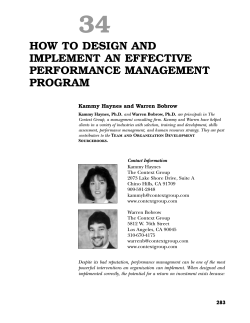
Records Chapter 3
Chapter 3 Records Assessors have responsibility for locating, identifying, inventorying, and valuing all property in their counties. The assessor must be able to explain and defend each assessed value. It is essential to maintain accurate records that show the underlying factors and procedures used. Office records used by assessors and their staffs include many documents, both in hard copy and computerized formats. Some of these records include: • Property transaction records; • Property description cards (tax lot cards); • Journal vouchers for tracking account changes; • Office or counter maps; • Appraisal maps; • Sales cards/sales printouts; • Sales questionnaires; • Ownership indexes; • Appraisal inventory cards; • Confidential real and personal property returns; • Exemption files/special assessment files; • DOR-appraised industrial and centrally assessed property files; • Real property assessment roll; • Personal property assessment roll; and • Administrative records. Examples and brief descriptions of some types of records used in an assessor’s office begin on the following page. 150-303-415 (Rev. 07/03) Appraisal Methods for Real Property Chapter 3 Page 1 of 12 Property Transaction Records Property transaction records include deeds, contracts, and any other instrument that conveys an interest in real property. These instruments may be documents recorded in the clerk or recorder’s office (in home–rule counties, the recorder’s office) or they may be provided to the assessor’s office by the taxpayer. A property transaction document usually contains the name(s) of the grantor(s) and grantee(s), type of transaction, a description of property, consideration, encumbrances (such as easements, severed mineral rights, and taxes owed), date of transaction, and the name and address of the party who is to receive the tax statement. Following is an example of a deed. 150-303-415 (Rev. 07/03) Appraisal Methods for Real Property Chapter 3 Page 2 of 12 Example of a Deed The form included here has been reproduced with the permission of Stevens-Ness Law Publishing Co. No further copying or reproduction in any form is permitted without the express permission of the Publisher. 150-303-415 (Rev. 07/03) Appraisal Methods for Real Property Chapter 3 Page 3 of 12 Property Description Record Property description records are commonly referred to as tax lot cards. Information on this record includes: • Map number; • Parcel number; • Special interest numbers; • Tax code area number; • A tie to the parent account; • Legal description; • Any tax lots that have been cancelled and combined with another tax lot; • Gross and net acres; • Deed references (important for history research purposes); • Geographic Information System (GIS) coordinates; and • Exceptions for roads, segregations, and easements. County assessors must set up and maintain a filing system that makes it easy to locate individual property accounts. The newer, manual tax lot card systems being installed in remapping projects list the property history on the front of the card and have a copy of the latest owner’s deed on the back. If tax lot cards are part of an automated system, they need to contain the same information as the manual tax lot card. Following is an example of a tax lot card. 150-303-415 (Rev. 07/03) Appraisal Methods for Real Property Chapter 3 Page 4 of 12 Example of Tax Lot Card (Front) 150-303-415 (Rev. 07/03) Appraisal Methods for Real Property Chapter 3 Page 5 of 12 Example of Tax Lot Card (Back) Journal Vouchers 150-303-415 (Rev. 07/03) Appraisal Methods for Real Property Chapter 3 Page 6 of 12 Journal Vouchers A journal voucher assures that the various steps necessary in assessment and taxation have been completed. The journal voucher form can either be hard copy or computerized. If the voucher is computer-generated, all information is entered directly into the system, thus eliminating the need for a hard copy. A journal voucher system that uses sequential numbering and is filed numerically makes it easy to locate vouchers. Include all information needed to update the assessment roll: • Grantor; • Grantee; • Affected tax lot(s); • New account number; • Deleted accounts; • Computer reference number; • Old and new acreage; • Reason for change; • Deed reference, including type of deed and date of deed; and • Check–off list associated with office flow to assure all required functions have been completed. Following is an example of a journal voucher. 150-303-415 (Rev. 07/03) Appraisal Methods for Real Property Chapter 3 Page 7 of 12 Assessor’s Journal Voucher 150-303-415 (Rev. 07/03) Appraisal Methods for Real Property Chapter 3 Page 8 of 12 Sales Data Records Use sales data records to analyze market data for appraisals (ORS 308.232 and ORS 308.233), to measure results against appraisal standards (ORS 308.234 and OAR 150308.234), and for the annual sales ratio study (ORS 309.200 and OAR 150-309.200). Sales information is taken from recorded instruments, such as deeds and contracts, and documentation like Multiple Listing Service data. This process is known as sales take-off. The office of the clerk or recorder and the cartography section of the assessor’s office identify the properties that have transferred or conveyed whole or partial ownership. In several counties, DOR’s cartography section performs the mapping duties under contract with the county. Written procedures with specific timelines can be developed to show the process of sales information moving quickly from the clerk’s office through the cartography section and on to the data analyst. The data analyst needs to ensure that the sales collection, confirmation, and qualification process is current. Following are examples of computerized sales data records. 150-303-415 (Rev. 07/03) Appraisal Methods for Real Property Chapter 3 Page 9 of 12 Examples of Sales Data Records Ascend Property Transfer Screens 150-303-415 (Rev. 07/03) Appraisal Methods for Real Property Chapter 3 Page 10 of 12 150-303-415 (Rev. 07/03) Appraisal Methods for Real Property Chapter 3 Page 11 of 12 150-303-415 (Rev. 07/03) Appraisal Methods for Real Property Chapter 3 Page 12 of 12
© Copyright 2025





















